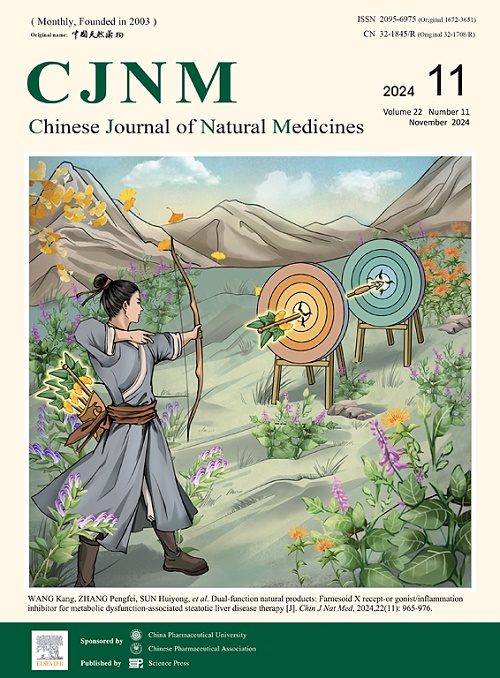First-in-class drug oroxylin A tablets for treating hepatic and gastrointestinal disorders: from preclinical development to clinical research
IF 4.9
2区 医学
Q1 INTEGRATIVE & COMPLEMENTARY MEDICINE
引用次数: 0
Abstract
Oroxylin A (OA) is a natural flavonoid primarily derived from the plants Oroxylum indicum and Scutellaria baicalensis. Currently, OA is obtainable through chemical synthesis and exhibits polypharmacological properties, including anti-cancer, anti-inflammatory, anti-microbial, and multi-organ protective effects. The first-in-class drug OA tablets are presently undergoing phase Ib/IIa clinical trials for hepatocellular carcinoma (HCC) treatment. Substantial evidence suggests that OA demonstrates therapeutic potential against various hepatic and gastrointestinal (GI) disorders, including HCC, hepatic fibrosis, fatty liver disease, hepatitis, liver injury, colitis, and colorectal cancer (CRC). OA exerts its therapeutic effects primarily by modulating several crucial signaling pathways, including those associated with apoptosis, oxidative stress, inflammation, glucolipid metabolism, and fibrosis activation. The oral pharmacokinetics of OA is characterized by phase II metabolism, hydrolysis, and enterohepatic recycling. This review provides a comprehensive overview of the critical stages involved in the development of OA tablets, presenting a holistic perspective on the progression of this first-in-class drug from preclinical to clinical phases. It encompasses the synthesis of active pharmaceutical ingredients, pharmacokinetics, pharmacological efficacy, toxicology, drug delivery, and recent advancements in clinical trials. Importantly, this review examines the potential mechanisms by which OA may influence the gut-liver axis, hypothesizing that these interactions may confer health benefits associated with OA that transcend the limitations posed by its poor bioavailability.
治疗肝脏和胃肠道疾病的一流药物奥罗霉素A片:从临床前开发到临床研究
Oroxylum indicum (Oroxylum)和黄芩(Scutellaria baicalensis)是一种主要从黄芩中提取的天然黄酮类化合物。目前,OA可通过化学合成获得,并具有多种药理作用,包括抗癌、抗炎、抗微生物和多器官保护作用。目前,OA片剂正在进行治疗肝细胞癌(HCC)的Ib/IIa期临床试验。大量证据表明,OA具有治疗多种肝脏和胃肠道疾病的潜力,包括HCC、肝纤维化、脂肪肝、肝炎、肝损伤、结肠炎和结直肠癌。OA主要通过调节几个关键的信号通路发挥其治疗作用,包括与凋亡、氧化应激、炎症、糖脂代谢和纤维化激活相关的信号通路。口服OA的药代动力学以II期代谢、水解和肠肝循环为特征。这篇综述提供了OA片剂开发的关键阶段的全面概述,从临床前到临床阶段的整体视角展示了这一一流药物的进展。它包括活性药物成分的合成、药代动力学、药理学功效、毒理学、药物传递和临床试验的最新进展。重要的是,本综述探讨了OA可能影响肠-肝轴的潜在机制,假设这些相互作用可能赋予OA相关的健康益处,超越其低生物利用度造成的限制。
本文章由计算机程序翻译,如有差异,请以英文原文为准。
求助全文
约1分钟内获得全文
求助全文
来源期刊

Chinese Journal of Natural Medicines
INTEGRATIVE & COMPLEMENTARY MEDICINE-PHARMACOLOGY & PHARMACY
CiteScore
7.50
自引率
4.30%
发文量
2235
期刊介绍:
The Chinese Journal of Natural Medicines (CJNM), founded and sponsored in May 2003 by China Pharmaceutical University and the Chinese Pharmaceutical Association, is devoted to communication among pharmaceutical and medical scientists interested in the advancement of Traditional Chinese Medicines (TCM). CJNM publishes articles relating to a broad spectrum of bioactive natural products, leading compounds and medicines derived from Traditional Chinese Medicines (TCM).
Topics covered by the journal are: Resources of Traditional Chinese Medicines; Interaction and complexity of prescription; Natural Products Chemistry (including structure modification, semi-and total synthesis, bio-transformation); Pharmacology of natural products and prescription (including pharmacokinetics and toxicology); Pharmaceutics and Analytical Methods of natural products.
 求助内容:
求助内容: 应助结果提醒方式:
应助结果提醒方式:


